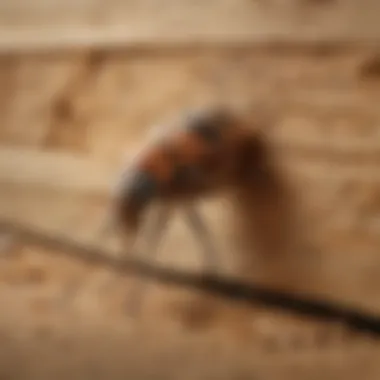Axiom Portland: Insights into Termite Control


Intro
Axiom Portland introduces a structured approach to termite control that resonates with both homeowners and pest control professionals. Understanding this framework is essential for effective pest management. The focus is not merely on addressing existing infestations, but also on creating a comprehensive strategy that incorporates prevention and long-term monitoring. This article aims to unravel the complexities of termite control, framing Axiom Portland as a pivotal element in crafting a reliable response to pest challenges.
Pest Identification
Identifying termites is crucial to mitigating damage to property. When examining a potential infestation, it is important to recognize the common types of termites:
- Subterranean termites are the most destructive subtype, typically nesting underground and entering structures through mud tubes.
- Drywood termites reside within the wood they consume, requiring different treatment methods.
- Dampwood termites thrive in decaying wood and are generally less of a concern for homes.
Signs and Symptoms of Infestations
Homeowners should watch for telltale signs of termite activity. These include:
- Mud tubes on walls or foundations, which show how termites travel.
- Wood damage, often visible as hollowed-out areas or sagging structures.
- Swarmers or discarded wings during the breeding season, hinting at an established colony.
"The sooner an infestation is detected, the less damage will occur, and the easier the control will be."
Recognizing these signs early can significantly reduce repair costs and complications in dealing with termites.
Prevention Strategies
Preventing termites is about maintaining a suitable environment around your home. Here are practical measures for homeowners:
- Regularly inspect your property for signs of moisture or wood contact with soil.
- Maintain gutters and downspouts to direct water away from the foundation.
- Store firewood and other wooden materials away from the house's perimeter.
Natural Deterrents and Barriers
Implementing natural barriers can be effective in deterring termites. Consider using:
- Boric acid is a well-known method that disrupts a termite's metabolism.
- Nematodes are microscopic worms that can be introduced into the soil to attack termites.
- Essential oils, like clove or orange oil, may serve as repellents.
These strategies can serve as a first line of defense against potential infestations.
Treatment Options
When prevention fails, addressing a termite problem is essential. Homeowners can choose between various treatment options that can be broadly categorized into chemical and natural treatments.
Overview of Chemical vs. Natural Treatments
- Chemical treatments often include liquid termiticides that create a barrier around the home, protecting it from subterranean termites. Products like Termidor or Taurus SC are popular and effective.
- Natural treatments, while less conventional, offer alternatives to harsh chemicals. Diatomaceous earth can be applied to infested areas, dehydrating and killing insects.
Step-by-Step Guides for DIY Treatments
For those who prefer a hands-on approach, the following simple steps can guide you:
- Identify the Infestation: Find out the type of termite and extent of damage.
- Choose a Treatment: Decide between chemical or natural options based on your comfort and circumstances.
- Apply Everything Properly: For instance, if using a chemical, follow the product's instructions rigorously.
- Monitor the Situation: After treatment, keep an eye out for new signs of termites.
By understanding the options available, homeowners can make informed decisions regarding their pest management approach. This synthesis of information will ensure a sound strategy that addresses termites effectively.
Intro to Axiom Portland
In recent years, termite management has seen a shift towards more holistic and informed approaches. Axiom Portland stands out as a notable framework within this evolution. Its principles offer a structured way to understand and combat termite infestations. For homeowners facing the threat of these pests, understanding Axiom Portland can be essential. This introductory section will explain what Axiom Portland is and why it matters in the broader context of pest control.
Defining Axiom Portland
Axiom Portland can be viewed as a conceptual framework for termite management. It is built on a foundation of scientific knowledge and practical applications. The name itself suggests a set of guiding principles that can be applied universally to termite control efforts. By emphasizing a systematic approach, Axiom Portland helps both professionals and homeowners to understand the complexities of termite behavior and the strategies necessary to mitigate their risks. In essence, it is not just about exterminating termites but also about understanding their life cycle and social structures.
Importance in Pest Control
The significance of Axiom Portland in pest control cannot be understated. It provides a roadmap for effective termite management that considers both immediate and long-term solutions. Here are some key points regarding its importance:


- Holistic Perspective: Axiom Portland encourages a comprehensive view of termite control, combining biological, environmental, and structural considerations.
- Effective Strategies: It offers various methodologies that have been proven to work, enhancing the chances of successful termite management.
- Educational Resource: Homeowners can learn about preventative measures, which empowers them to protect their homes better.
- Adaptability: This framework can be tailored to different environments and infestations, making it a flexible solution in pest control.
By integrating these aspects, Axiom Portland plays a crucial role in modern pest control practices, enabling more effective management of termite populations.
Understanding Termite Behavior
Understanding termite behavior is crucial for effective pest management. It provides insight into their biology, social structures, and habits. Knowledge of these aspects aids in selecting the right treatment methods and strategies for prevention. By grasping the intricacies of termite behavior, homeowners and pest control professionals can better anticipate infestations and mitigate risks.
Biology of Termites
Termites are social insects belonging to the order Blattodea. They have a complex life cycle which includes the egg, nymph, and adult stages. An important feature of termites is their dependence on cellulose, which they obtain from wood, plants, and decaying matter. Their digestive system contains specialized microbes that help break down cellulose into usable energy.
The lifespan of a termite varies widely. Worker and soldier termites typically live for about one to two years, while reproductive termites, known as kings and queens, can live for several years, with queens living up to decades. This longevity plays a role in the stability of a colony, allowing it to thrive and expand.
In addition to their diet, termites impact their environment significantly. They contribute to nutrient cycling by decomposing dead plant material. This behavior supports soil fertility, which is beneficial for plant growth. Understanding the biology of termites emphasizes their role in ecosystems but also their potential destructiveness when they infest wooden structures in homes.
Social Structure and Habits
Termite colonies exhibit fascinating social organization. They are divided into three main castes: workers, soldiers, and reproductives. Workers are responsible for most tasks, such as foraging, nest maintenance, and caring for the young. Soldiers defend the colony against threats and predators. Reproductive termites are responsible for producing offspring. This caste system ensures specialization, efficiency, and survival of the colony.
Termite habits include building and maintaining elaborate nests. Some species construct mud tubes for protection while traveling to food sources. Others create extensive networks of tunnels in the wood. Their social interactions are highly dependent on communication through chemicals called pheromones. This allows them to coordinate activities effectively.
Furthermore, understanding these social dynamics is essential in pest control strategies. Since termites rely on each other for functioning, targeting the colony’s queen can disrupt the population. Moreover, knowing their foraging patterns aids in developing effective baiting strategies. Homeowners can also anticipate when and where infestations may occur.
In summary, by gaining insights into termite behavior, one can implement more effective control measures. Educated decisions can significantly enhance pest management outcomes, providing long-term protection against these wood-destroying insects.
Understanding how termites operate on both biological and social levels will empower homeowners to tackle potential infestations with informed remedies. This knowledge is indispensable in maintaining the integrity of their homes.
Core Principles of Axiom Portland
Understanding the core principles of Axiom Portland is essential for effective termite management. These principles offer a structured approach that balances both science and practicality. They aim to equip homeowners and pest control professionals with actionable strategies to combat termite infestations. The advantages of adhering to these principles include increased effectiveness in pest management and long-term sustainability of solutions. This section highlights key ideas and considerations that shape the Axiom Portland approach.
Comprehensive Analysis
A comprehensive analysis forms the backbone of Axiom Portland. It entails a thorough understanding of termite behavior, environmental considerations, and the specific needs of a property. This analysis allows for tailored interventions that significantly increase the success rate of pest control efforts.
Key components in this analysis include:
- Identification of Termite Species: Different termite species exhibit varied behaviors. Understanding whether a homeowner is dealing with subterranean or drywood termites informs the choice of treatment.
- Assessment of Property Structure: A detailed examination of the building's structure helps in locating potential entry points and nests. Identifying hidden weaknesses can prevent future infestations.
- Evaluation of Environmental Factors: Factors such as moisture levels and wood type play a crucial role in termite attraction. A wet area in or around the house can create an ideal environment for termites.
"A well-executed analysis provides clarity and direction to pest control efforts, maximizing the chances for success."
Conducting a comprehensive analysis not only aids in immediate problem-solving but also helps develop preventive measures, ensuring that termite issues do not reoccur.
Integration of Methodologies
Integration of methodologies is another fundamental principle within Axiom Portland. This involves combining various pest control techniques to create a coherent strategy that addresses the complexities of termite behavior. The integration seeks to provide a multidisciplinary approach, drawing from both traditional practices and modern innovations.
Principally, this integration includes:
- Natural Remedies: These can serve as initial deterrents. Substances like nematodes and beneficial fungi are integrated into treatment plans to support eco-friendly practices.
- Chemical Solutions: While natural methods are valuable, conventional pesticides may be necessary for severe infestations. Integrating the two methods can help balance effectiveness and environmental safety.
- Monitoring Techniques: Active monitoring creates an ongoing defense mechanism. This involves using bait systems or traps strategically placed to detect and treat terms discreetly.
By amalgamating various methodologies, Axiom Portland presents an adaptable and robust defense against termites. This integration respects the environment while effectively addressing immediate pest control needs.
Effective Termite Treatment Options
Effective treatment options for termites are critical for safeguarding structures and maintaining a safe living environment. As termite infestations often lead to substantial damage, understanding various control methods empowers homeowners and pest management professionals. This section will explore two principal categories of treatment: natural remedies and chemical solutions.
Natural Remedies
Natural remedies offer an eco-friendly approach to termite control. These methods often leverage substances from nature that can deter or eliminate termites without the harsh effects of synthetic chemicals. Their use is generally regarded as safe for residential areas, particularly where children and pets are present.


Some effective natural remedies include:
- Nematodes: Beneficial nematodes are microscopic worms that prey on termites. When introduced to infested areas, they can effectively reduce termite populations.
- Boric acid: This substance acts as a stomach poison to termites when ingested. It can be applied as a powder in areas known for termite activity or mixed with sugar to entice termites to consume it.
- Orange oil: Known for its pleasant scent, orange oil contains d-limonene, which can kill termites on contact. It is useful for targeted application in galleries and other infested areas.
- Vinegar: While not as lethal, vinegar can be mixed with lemon juice to create a solution that disrupts termite activity when sprayed directly on them.
While these remedies can be effective, they often require persistent monitoring and reapplication to ensure success. They may work best in conjunction with other methods, forming part of an integrated pest management strategy.
Chemical Solutions
Chemical solutions are traditionally the most common approach to termite control. These solutions can range from preventative treatments to direct extermination. Understanding the chemical options available is essential for making informed decisions about termite control strategies.
Key chemical solutions include:
- Liquid termiticides: These are applied around the perimeter of structures to create a barrier that prevents termites from entering. Products like Termidor and Champion are often noted for their effectiveness.
- Baiting systems: Products such as Sentricon utilize bait stations placed in the soil. The bait contains substances that termites take back to their colony, leading to the eventual elimination of the whole colony.
- Foam treatments: Foam-based insecticides can penetrate voids and hard-to-reach areas, providing a thorough treatment application.
- Fumigation: This is a method applied in severe infestations where tents are placed over the structure. Pesticides are dispersed to eliminate termites at all life stages. This process can be more disruptive and requires homeowners to vacate the premises temporarily.
While chemical solutions may be more immediately effective, it is crucial to consider safety precautions, environmental impact, and future resistance issues. Regular consultation with pest control experts is advisable to choose the most suitable approaches, depending on specific situations.
Effective termite control often relies on a combination of methods, ensuring a comprehensive approach to preserving home integrity.
In summary, the choice between natural remedies and chemical solutions will largely depend on individual preferences, specific infestation scenarios, and environmental considerations. Understanding the strengths and limitations of each method will greatly enhance decision-making in termite management.
Implementation Strategies
In termite control, effective implementation strategies are crucial for the success of pest management. These strategies not only dictate how treatments are carried out but also ensure that they are sustainable and environmentally friendly. Recognizing and utilizing these strategies can prevent further infestations and protect one’s investment in property.
Assessment and Identification
Assessment and identification are the foundational steps in combating termite infestations. It involves a thorough inspection of the property to determine the type and extent of the infestation. Understanding the specific species of termite is key, as different types may require varied control methods. For instance, Subterranean termites often create mud tubes, while drywood termites may leave behind small pellets.
Homeowners can identify signs of infestation, such as:
- Hollow-sounding wood
- Mud tubes near foundations
- Swarmers or discarded wings
Engaging a professional pest control service is advised for a detailed assessment. Trained specialists can identify damage that may not be visible to the untrained eye. Once the extent of the infestation is clear, appropriate treatment options can be considered.
Monitoring Techniques
Post assessment, monitoring techniques play a significant role in termite management. Continuous monitoring is essential for determining the effectiveness of treatments and spotting any new activity before it escalates. Homeowners are encouraged to utilize a combination of techniques, including:
- Baiting Systems: These are strategically placed around the property to attract and kill termites.
- Moisture Detectors: Since termites are moisture-dependent, these tools can help identify areas susceptible to infestation.
- Regular Inspections: Routine inspections by professionals can help in identifying early signs of termite activity.
Continuous monitoring can greatly reduce the risk of future infestations, ultimately saving homeowners time and money.
Utilizing both assessment and monitoring techniques in a systematic manner strengthens the overall plan of termite control. Homeowners equipped with these insights can advocate for thorough evaluations and establish a diligent monitoring schedule, solidifying protection against termites.
Challenges in Termite Control
The process of managing termite infestations poses numerous challenges that require careful consideration. Homeowners are often unaware of the complexities involved in termite control. Understanding these challenges is crucial for both effective management and prevention strategies. This section illuminates the significant hurdles in termite control, focusing on two key aspects: resistance and adaptation, as well as environmental impact.
Resistance and Adaptation
Termites, like many pests, display a remarkable ability to adapt to various control measures. Over time, certain species develop resistance to chemical treatments commonly used by pest control professionals. This evolution can result in a cycle of repeated treatments with diminishing returns. For example, termites may develop the ability to metabolize or detoxify pesticides, reducing their effectiveness. This characteristic creates challenges for traditional pest management strategies that rely heavily on these chemicals.
Homeowners need to be aware that even the most reputable pest control companies can face limitations due to this resistance. A diversified approach that incorporates both chemical and non-chemical solutions is often necessary. Recognizing the signs of termite activity early can help in mitigating these challenges. Regular inspections and monitoring are essential in identifying changes in termite behavior and resistance patterns.
Environmental Impact
Another significant challenge in termite control is the environmental impact of various treatments. Many chemical options can pose risks not just to pests but also to humans, pets, and local ecosystems. In some cases, chemical treatments can affect beneficial insects and disrupt local biodiversity. Homeowners should consider the long-term effects of pest control methods. Sustainable practices in termite management are not just favorable for the environment; they can also lead to healthier living spaces.
It is important for individuals to seek out pest control approaches that prioritize environmental health. For example, organic treatments and methods that use natural barriers are gaining popularity. These options often provide effective solutions while minimizing damage to the ecosystem.
"Understanding the balance between effective termite control and environmental considerations is key to a successful long-term strategy."


By being informed about these challenges, homeowners can make better decisions regarding their pest management strategies. Recognizing the complexities of termite behavior and the environmental ramifications of various treatments helps in developing a well-rounded approach to termite control.
Debunking Common Myths
The topic of debunking common myths related to termite control is crucial for homeowners and pest control professionals alike. Misconceptions can lead to unwarranted fears and ineffective practices. Understanding these myths helps create a more informed approach to termite management—lowering anxiety while enhancing effectiveness.
Exaggerated Risks
One major myth surrounding termites is the exaggerated risk they pose to a property. Many people believe that a small infestation will quickly escalate into a catastrophic problem. While termites can cause substantial damage, the timeline for this damage is often not immediate. In reality, it can take years for termites to compromise a structure significantly. Knowledge of this timeline can relieve homeowners' anxieties and encourage them to seek professional evaluations rather than panicking.
Common misunderstandings include:
- All termites are destructive. While some species do cause damage, others may not pose a significant threat to homes.
- Visible damage is a sign of a current infestation. Not all damage visible on surfaces indicates live termites. Older damage can occur long before it becomes noticeable.
Recognizing these myths allows homeowners to take a measured approach. A professional inspection can establish the presence and extent of an infestation accurately.
Ineffective Solutions
Another prevalent myth concerns the efficacy of various “do-it-yourself” solutions for termiticides and treatments. Many products claim to eliminate problems with minimal effort. However, such solutions often lack scientific backing. Homeowners may find themselves investing in solutions that do not address the root of the issue.
Some commonly pursued ineffectual solutions are:
- Home remedies such as vinegar or essential oils. While these might deter some pests, they fail to address established infestations.
- Over-the-counter pesticides. These products are often not designed for deep penetration into wood or soil, meaning they may not reach the termites’ nest effectively.
Addressing these myths is essential. It encourages homeowners to seek professional pest management services that utilize proven methods and products. Understanding the limitations of DIY methods ensures that solutions implemented are proactive rather than reactive.
"Misinfo about termite control can lead to serious mistakes in management and application."
Future Innovations in Pest Control
The landscape of pest control is evolving rapidly, with Axiom Portland as a central figure in this transformation. Understanding future innovations in pest control is essential for homeowners and pest management professionals alike. These advancements hold the promise of more effective methods to combat termites, while also improving ecological health. Moreover, integrating technology and sustainable practices will not only enhance treatment efficacy but also promote a more responsible approach to pest management.
Technology Integration
Technological advancements in pest control offer numerous benefits, particularly in termite management. Tools such as smart sensors can detect termite activity more accurately and at an early stage. These sensors can send real-time data to homeowners and pest control experts, enabling swift action before infestations worsen. The use of technology also aids in the development of targeted treatment methods, reducing chemical use and minimizing environmental impact.
Among notable technology integrations are thermal imaging cameras, which help identify areas of termite activity that are otherwise invisible. These innovations heighten the precision of inspections and assure homeowners that their property is well-monitored. Moreover, technology enables pest control companies to maintain detailed records of treatment methods and outcomes, facilitating ongoing analysis and improvement of strategies.
Sustainable Practices
Sustainability is becoming a cornerstone in pest control, particularly when considering the implications of chemical treatments on the environment. Axiom Portland promotes practices that prioritize ecological balance and health. For instance, many pest control companies are exploring natural repellents derived from plants and organic compounds as alternatives to harsh chemicals.
Additionally, integrated pest management (IPM) is gaining popularity. This approach combines biological, cultural, and mechanical control methods. Strategies like introducing natural predators or implementing exclusion methods can effectively manage termite populations without heavily relying on chemicals.
A focus on sustainable practices contributes to the long-term health of ecosystems surrounding residential areas. Homeowners are encouraged to adopt methods that not only solve pest issues but also maintains their landscape and community environment.
In summary, the future of pest control hinges on embracing technological innovations and sustainable methods. Adapting these approaches will empower homeowners to manage risks associated with termites while fostering a healthier ecosystem for future generations.
The End and Recommendations
The final section of this article encapsulates key insights into Axiom Portland and its application in termite control. Drawing from extensive analysis, it highlights not only effective practices but also offers guidance for homeowners aiming to protect their investments against termite damage.
Summarizing Effective Practices
Addressing termite infestations requires a multifaceted strategy grounded in the principles of Axiom Portland. Homeowners should consider implementing the following effective practices:
- Routine Inspections: Regular checks for signs of termite activity can prevent extensive damage. Look for mud tubes, discarded wings, and damaged wood.
- Moisture Control: Termites thrive in damp environments. Ensure proper drainage around the home by fixing leaky pipes and maintaining gutters.
- Soil Treatment: Utilizing termiticides during construction or renovation is an effective preventive measure. Consider using products like Termidor or Premise to create a barrier against termites.
- Wood Treatment: Treating wood with borate can protect it from termite infestation. This option is especially useful for exposed wood structures.
- Landscaping Considerations: Keep mulch and plant material away from the foundation of the home. Wood mulch can attract termites.
- Documentation of Treatments: Maintain records of any pest control treatments. This can be vital for follow-up inspections and claims.
Incorporating these strategies can enhance protection against termites effectively.
Guidance for Homeowners
For homeowners, knowledge about termite control is paramount. Here are essential considerations when applying Axiom Portland's insights:
- Be Informed: Understanding the biology and behavior of termites helps in recognizing potential risks. Knowledge leads to proactive measures.
- Choose Professionals Wisely: When needed, select pest control professionals based on their expertise with Axiom Portland methodologies. Verify certifications and reviews.
- Evaluate Treatment Options: Not all treatments are equally effective. Homeowners should research the latest innovations and evaluate their environmental impact before making decisions.
- Access Local Resources: Use local resources such as university extension services or reliable pest control websites. Valuable insights are often available to help homeowners make informed choices.
- Engagement with Neighbors: Discussing pest management with neighbors can lead to community-wide efforts. Coordinated actions can reduce the risk of infestations spreading.
"Proactive measures in termite control can save homeowners considerable costs and distress in the long run."
Arming homeowners with these insights ensures that they are better prepared to tackle potential termite threats and secure their homes against damage. A combination of awareness, preventive strategies, and professional advice can go a long way in maintaining a termite-free environment.



